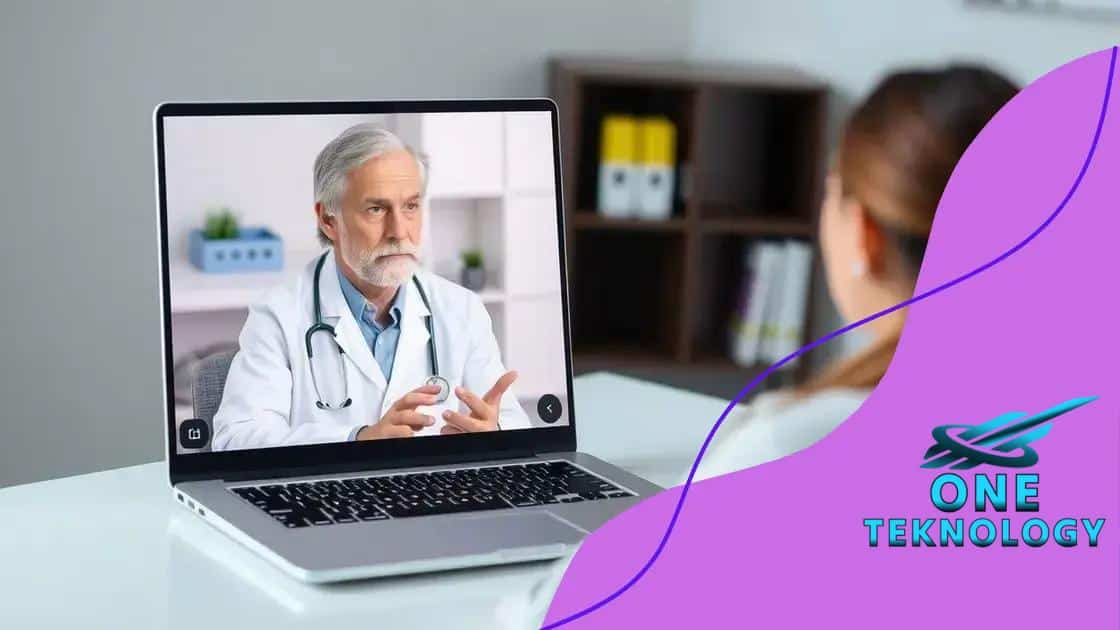The role of telemedicine in expanding healthcare access

The role of telemedicine in expanding healthcare access includes improving patient convenience, increasing accessibility, and reducing costs, while enhancing communication and engagement between patients and providers.
The role of telemedicine in expanding healthcare access is increasingly vital in today’s world. Imagine accessing a doctor without leaving your home! This technology is reshaping our healthcare landscape. Let’s dive in and see how.
Understanding telemedicine’s impact
Understanding telemedicine’s impact reveals how this innovative approach is changing healthcare today. The integration of technology in healthcare services is making it easier for patients to connect with experts. As we explore this topic, several key factors come into play.
The Reach of Telemedicine
Telemedicine extends medical care beyond traditional boundaries. Patients in remote areas can access specialists without traveling long distances. This innovative delivery method not only saves time but also improves patient outcomes.
Key Benefits of Telemedicine
- Convenience: Patients can schedule virtual visits from the comfort of their home.
- Cost-effectiveness: Reducing travel time can save on overall healthcare costs.
- Increased accessibility: Individuals with mobility issues can receive necessary care.
The impact of telemedicine is profound. It empowers patients by offering more options. When patients feel informed and in control, their experience improves significantly.
Additionally, telemedicine fosters a feeling of immediacy in the healthcare process. Patients can receive advice and care quickly, which is crucial. The convenience factor cannot be overstated in today’s fast-paced world.
Technology continues to evolve. As more healthcare providers adopt telemedicine, we may see an even broader range of services available virtually. This evolution enhances the quality of care, ultimately benefiting everyone involved.
Key benefits of telemedicine
Telemedicine offers numerous benefits that enhance the healthcare experience for patients and providers alike. Its rise in popularity is no surprise, given the value it brings to the table.
Convenience and Flexibility
One of the main advantages of telemedicine is its convenience. Patients can schedule appointments from home, eliminating travel time and waiting in crowded offices. This flexibility allows for easier access to healthcare, especially for those with busy schedules or mobility challenges.
Cost Savings
- Reduced travel expenses: Patients save on gas, parking, and public transportation.
- Lower healthcare costs: Telemedicine visits can be less expensive than in-person appointments.
- Insurance coverage: Many providers now cover telehealth services, making it affordable.
Another significant benefit is the ability to access specialists. Patients in rural areas, for example, can connect with top experts without long journeys. This access not only improves individual care but also elevates healthcare standards in underserved communities.
Additionally, telemedicine can lead to quicker diagnoses and treatments. When patients can connect with healthcare professionals rapidly, they receive timely advice. This can result in earlier interventions, ultimately fostering better health outcomes.
Furthermore, telemedicine enhances continuity of care. Patients are more likely to follow-up on their health issues when it’s easy to do so. Regular check-ins using digital platforms help maintain ongoing relationships between patients and their providers.
Challenges faced in telemedicine adoption

While telemedicine offers many benefits, it also faces significant challenges that can hinder its adoption. Addressing these obstacles is crucial for improving access to healthcare.
Technological Barriers
Many patients and providers encounter difficulties due to technology. Not everyone has access to reliable internet or devices suitable for telehealth services. This digital divide can exclude vulnerable populations from receiving care.
Regulatory and Legal Issues
Telemedicine regulations differ across states and countries, creating confusion. Providers must navigate complex laws regarding where they can practice and which services they can offer remotely. These legal hurdles can slow down the adoption of telehealth solutions.
Resistance to Change
Some healthcare professionals may be hesitant to adapt to new technologies. This resistance can stem from a lack of training or unfamiliarity with virtual consultations. As a result, many may prefer traditional in-person visits, limiting the potential of telemedicine.
Moreover, patients might feel uneasy about using technology for their healthcare needs. Concerns about privacy and data security can prevent individuals from fully embracing telemedicine options. Ensuring robust security measures is essential to build trust.
Integrating telemedicine into existing healthcare frameworks can also present challenges. It requires adjustments to workflows, communication strategies, and patient management systems. These changes can take time and resources that some practices may not have at their disposal.
Despite these challenges, the potential of telemedicine remains vast. By addressing these issues, healthcare providers can better harness the benefits of virtual care for everyone.
Technological advancements driving telemedicine
Technological advancements are rapidly transforming the landscape of telemedicine. These innovations enhance how patients and healthcare providers connect and communicate. As the industry evolves, several key technologies stand out.
High-Speed Internet Access
Access to high-speed internet is crucial for effective telemedicine. It allows for seamless video consultations and instant communication. Without reliable internet connections, many people may struggle to access virtual healthcare.
Mobile Health Applications
Mobile health apps are becoming essential tools in telemedicine. These applications enable patients to manage their health from their smartphones. They can schedule appointments, access medical records, and even communicate with doctors anytime. This convenience encourages more people to use telehealth services.
Wearable Technology
- Health monitoring: Wearable devices like fitness trackers and smartwatches can monitor vital signs and share data with healthcare providers.
- Data collection: These devices provide valuable data to doctors, helping them make informed decisions about patient care.
- Real-time feedback: Patients receive immediate tips and feedback based on their health data.
Artificial Intelligence (AI) is also playing a vital role in telemedicine. AI can analyze patient data and assist in diagnosis. This technology improves the accuracy and efficiency of care. For example, chatbots powered by AI can provide instant responses to patient inquiries, allowing for quicker resolutions.
Furthermore, advancements in data security are essential for protecting patient information. As telemedicine grows, ensuring secure communication channels is a priority. Technologies like end-to-end encryption help safeguard sensitive data, fostering trust in virtual healthcare.
The future of healthcare with telemedicine
The future of healthcare with telemedicine is looking bright and promising. As technology advances, we can expect significant changes in how patients receive care. Telemedicine is becoming a permanent fixture in modern healthcare.
Increased Adoption Rates
More healthcare providers are embracing telemedicine as part of their services. This shift means that patients will have even greater access to virtual consultations. The convenience of remote healthcare is appealing to both patients and providers, leading to higher adoption rates across various medical fields.
Integration with Traditional Care
Telemedicine will not replace traditional healthcare; instead, it will complement it. Many providers plan to integrate telehealth services into their existing practices. This hybrid model will allow patients to choose the type of service that best suits their needs.
Advancements in Technology
- Artificial Intelligence: AI will play a larger role in diagnosing and managing patient care, making healthcare more efficient.
- Remote Monitoring: Technologies that monitor patient vitals in real time will improve health outcomes and reduce hospital visits.
- Personalized Medicine: Telemedicine will facilitate personalized treatment plans based on data collected through various digital platforms.
As telemedicine grows, it’s essential to prioritize patient privacy and security. With more health information being shared online, robust cybersecurity measures will be necessary. This focus on safeguarding personal data will be vital for building trust in telehealth platforms.
Moreover, healthcare policy will likely evolve to keep pace with telemedicine. Governments may implement new regulations to ensure quality care remains a priority. The future will also see increased funding for healthcare technologies to support the telemedicine expansion.
Overall, the future of healthcare with telemedicine is set to be more accessible, efficient, and patient-centered. As both technology and care models continue to evolve, we can look forward to a healthcare environment that meets the needs of a diverse population.
FAQ – Frequently Asked Questions about Telemedicine
What is telemedicine?
Telemedicine is the use of technology to provide medical care remotely, allowing patients to consult with healthcare providers without needing to travel.
How can telemedicine improve healthcare access?
Telemedicine increases healthcare access by connecting patients with providers regardless of location, especially benefiting those in remote or underserved areas.
What are the main benefits of using telemedicine?
The main benefits include convenience, reduced travel time, cost savings, and improved patient engagement through enhanced communication.
What challenges are associated with telemedicine?
Challenges include technological barriers, regulatory issues, resistance to change from providers, and concerns about patient privacy and data security.






